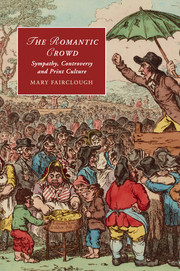Crossref Citations
This Book has been
cited by the following publications. This list is generated based on data provided by Crossref.
Higgins, David
2014.
Romantic Englishness.
p.
162.
Solomonescu, Yasmin
2014.
John Thelwall and the Materialist Imagination.
p.
1.
de Groote, Brecht
2014.
The Glory of Motion: Re-Reading Movement in Thomas De Quincey and Adam Smith.
European Romantic Review,
Vol. 25,
Issue. 3,
p.
267.
Johnson, Amanda Louise
2014.
William Hazlitt,Liber Amoris, and the Imagination.
European Romantic Review,
Vol. 25,
Issue. 6,
p.
743.
2015.
Radical Orientalism.
p.
263.
Jensen, Oskar Cox
2015.
Napoleon and British Song, 1797–1822.
p.
74.
2015.
Romanticism.
p.
278.
2017.
Urbanization and English Romantic Poetry.
Walford Davies, Damian
2017.
John Keats and the Medical Imagination.
p.
207.
Sharren, Kandice
2017.
The Texture of Sympathy: Narrating Sympathetic Failure in Frances Burney’sCamillaandThe Wanderer.
European Romantic Review,
Vol. 28,
Issue. 6,
p.
701.
Marggraf Turley, Richard
2017.
John Keats and the Medical Imagination.
p.
173.
2017.
Women Wanderers and the Writing of Mobility, 1784–1814.
p.
289.
Fairclough, Mary
2018.
Romantic electricity: Fields and currents in recent research.
Literature Compass,
Vol. 15,
Issue. 2,
Gurton‐Wachter, Lily
2018.
Sympathy between disciplines.
Literature Compass,
Vol. 15,
Issue. 3,
2019.
The Italian Idea.
p.
260.
2019.
The Italian Idea.
p.
116.
Doty, Benjamin Joshua
2019.
Fourierism and Nervous Sympathy inThe Blithedale Romance.
Nathaniel Hawthorne Review,
Vol. 45,
Issue. 1,
p.
26.
2019.
The Italian Idea.
p.
59.
2019.
The Italian Idea.
p.
1.
2019.
The Italian Idea.
p.
ix.



